Intel Core i9-10850K Review: The Real Intel Flagship
by Dr. Ian Cutress on January 4, 2021 9:00 AM EST- Posted in
- CPUs
- Intel
- Core
- Z490
- 10th Gen Core
- Comet Lake
- LGA1200
- i9-10850K
Gaming Tests: Grand Theft Auto V
The highly anticipated iteration of the Grand Theft Auto franchise hit the shelves on April 14th 2015, with both AMD and NVIDIA to help optimize the title. At this point GTA V is super old, but still super useful as a benchmark – it is a complicated test with many features that modern titles today still struggle with. With rumors of a GTA 6 on the horizon, I hope Rockstar make that benchmark as easy to use as this one is.
GTA doesn’t provide graphical presets, but opens up the options to users and extends the boundaries by pushing even the hardest systems to the limit using Rockstar’s Advanced Game Engine under DirectX 11. Whether the user is flying high in the mountains with long draw distances or dealing with assorted trash in the city, when cranked up to maximum it creates stunning visuals but hard work for both the CPU and the GPU.
We are using the following settings:
- 720p Low, 1440p Low, 4K Low, 1080p Max
The in-game benchmark consists of five scenarios: four short panning shots with varying lighting and weather effects, and a fifth action sequence that lasts around 90 seconds. We use only the final part of the benchmark, which combines a flight scene in a jet followed by an inner city drive-by through several intersections followed by ramming a tanker that explodes, causing other cars to explode as well. This is a mix of distance rendering followed by a detailed near-rendering action sequence, and the title thankfully spits out frame time data. The benchmark can also be called from the command line, making it very easy to use.
There is one funny caveat with GTA. If the CPU is too slow, or has too few cores, the benchmark loads, but it doesn’t have enough time to put items in the correct position. As a result, for example when running our single core Sandy Bridge system, the jet ends up stuck at the middle of an intersection causing a traffic jam. Unfortunately this means the benchmark never ends, but still amusing.
| AnandTech | Low Resolution Low Quality |
Medium Resolution Low Quality |
High Resolution Low Quality |
Medium Resolution Max Quality |
| Average FPS | 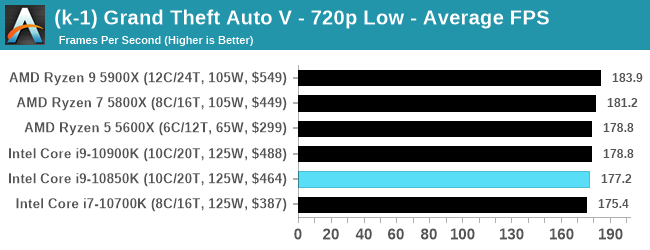 |
 |
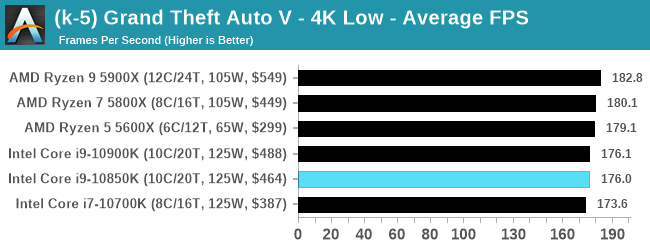 |
 |
| 95th Percentile |  |
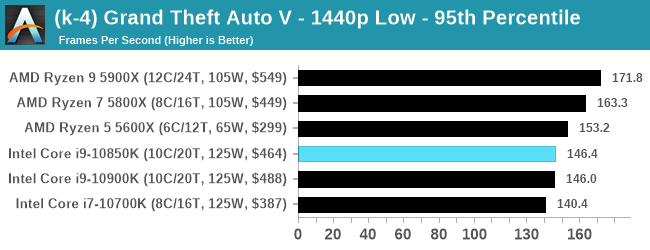 |
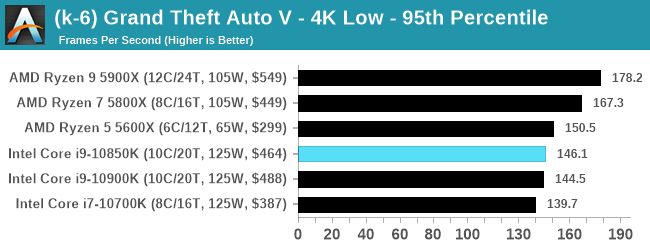 |
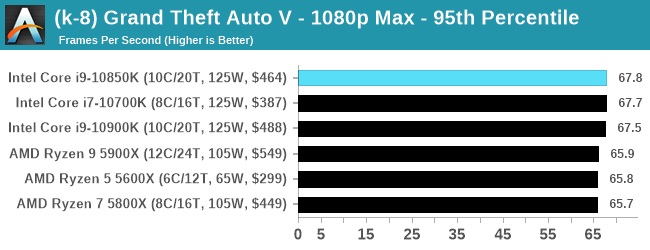 |
All of our benchmark results can also be found in our benchmark engine, Bench.


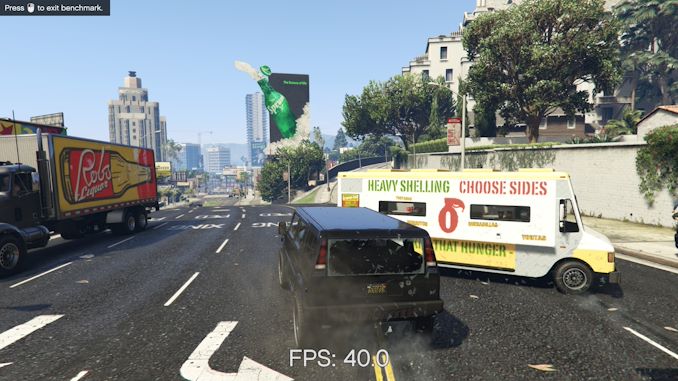









126 Comments
View All Comments
Deicidium369 - Monday, January 4, 2021 - link
And TSMC is really killing the fabrication front with the inability to ship anything in meaningful numbers - due to a extremely fragile supply chain - other than Apple - everything else in still on some variation of TSMC's 10nm class process - they call "7nm"sadick - Monday, January 4, 2021 - link
You are right, but Intel desktop CPUs are manufactured on the 14nm process since 2014!!! Ok, it's 14++++ now, but what an evolution, I'm very impressed ;-)I'm not an AMD fan boy, actually using a i7-9700k!
regsEx - Thursday, January 7, 2021 - link
At least they are much cheaper. 10-core 10850K cost same as 6-core 5600X.Impostors - Monday, January 4, 2021 - link
So is apple? Lmfao you thought they were making the chips? TSMC isn't behind on production, they are the production for literally everyone, from PC to mobile.name99 - Monday, January 4, 2021 - link
"you could argue that was the right call given the state of the market"Only if you drank your own koolaid about the end of Moore's Law...
Remember a book called _Only the Paranoid Survive_? About how in High Tech there are *constant* upsets and changes, nothing ever stays the same?
Hmm, if only someone at Intel had read that book and though "Gee, this seems to describe an industry very much like the one in which we operate"...
0ldman79 - Saturday, January 9, 2021 - link
Playing it safe would have been fine if they had a product to release afterwards.Thing is they didn't. They got so cocky they screwed up their fabs, reached too far while physics are only getting tougher to overcome.
TSMC made 7nm work, whether it hit their target density and speed goals or not it works. Intel had a goal and rather than back off as needed to release a product they kept fighting to hit an ego check-mark. When 10nm didn't work they should have backed off the density and tried again in order to release a product. Ultimately that's what they had to do but they did it 3 years too late.
WaltC - Monday, January 4, 2021 - link
M1 has very little in software and hardware compatibility to recommend it, however. Those are the #1 reasons people buy computer systems--raw performance is merely icing on the cake. AMD blows the M1, and Intel CPUs, away, imo. As it sits today, the M1 is not competitive with AMD (or even Intel, actually) in terms of multithreaded performance desktops & enterprise-level offerings. I very much doubt Apple will be going there--but we shall see...M1 as it sits is a good beginner's start...let's see where it goes from there.Great_Scott - Monday, January 4, 2021 - link
The techie rant from the early 2000's is coming to pass, finally.So many programs are either mobile or browser-based that the M1 is going to get a pass on compatibility.
Apple got lucky on the timing, in other words.
name99 - Monday, January 4, 2021 - link
Geniuses (and genius companies) make their own timing...Seems kinda bizarre to consider the rise of mobile computing as an exogenous factor when discussing Apple!
Calin - Tuesday, January 5, 2021 - link
Just read an article about Flash no longer being supported... and it was instead replaced by HTML5 and the like...Guess that genius companies really are lucky indeed ;)